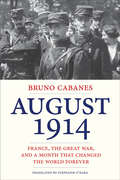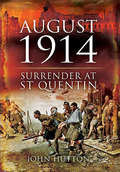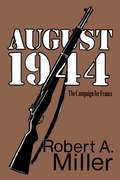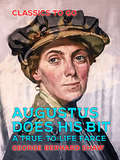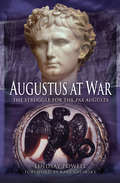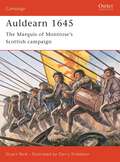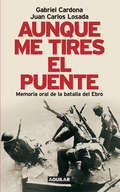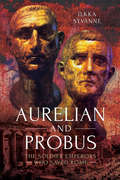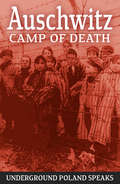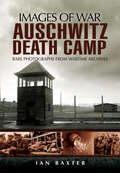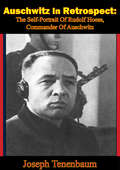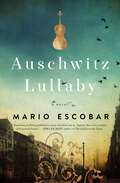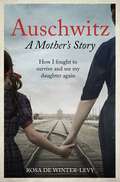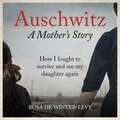- Table View
- List View
Audacity (Commander Cochrane Smith Naval Thrillers)
by Alan EvansCommander Cochrane Smith must battle through treacherous waters in this First World War naval thriller. Spring, 1918 : Bolshevik Russia has withdrawn from the war and now stands isolated, ineffectually hostile to both Germany and the Allied Forces. The Russian fleet at Kronstadt remains highly vulnerable, and the British government fears that a German offensive to ‘liberate’ the Kronstadt naval force could swing the balance of seapower against the Royal Navy. Commander David Cochrane Smith is captain of Audacity, a Q ship, no more than a lightly armed disguised tramp steamer. He is ordered to deliver a fortune in gold and a mysterious female passenger to a group of Russian plotters who are prepared to sink the fleet and block German access to the harbour. The only way through is to penetrate the defences of the Baltic’s minefields and patrolling destroyers. Smith’s one protection is Audacity’s disguise as a neutral ship: if that is stripped away his orders are to scuttle her because the Admiralty believes escape to be impossible… This action-filled First World War thriller is perfect for fans of Jack Higgins, Alexander Fullerton and Douglas Reeman.Praise forAudacity'I think a 21 gun salute is required … Alan Evans has produced a cracking thriller' Daily Mirror'Evans provides a different sea story, sustained suspense and vivid battle scenes' Publishers Weekly
Aufrüstung als europäische Friedensstrategie?: Friedensethik nach der Zeitenwende • Band 3 (Gerechter Frieden)
by Ines-Jacqueline WerknerEuropa ist durch die aktuellen weltpolitischen Konstellationen in doppelter Weise herausgefordert: zum einen durch den Ukrainekrieg und ein zunehmend revisionistisches Russland; zum anderen durch die zweite Amtszeit von Donald Trump und das nicht erwartete Ausmaß des Politikwechsels in den USA. Für den Frieden und die Sicherheit in Europa haben diese Entwicklungen fatale Konsequenzen. Gegenwärtig wäre Europa nicht in der Lage, sich selbst – ohne die USA – zu verteidigen. Vor diesem Hintergrund scheint eine möglichst schnelle militärische Aufrüstung in Europa einschließlich eines europäischen Atomschirmes das Gebot der Stunde zu sein. Die Autorinnen und Autoren dieses Bandes diskutieren die Notwendigkeiten, aber auch die Risiken, die mit einer solchen (neo)realistischen Friedensstrategie einhergehen.
Auftragstaktik: The Basis For Modern Military Command
by Major Michael J. GuntherGen. Helmuth von Moltke, the Chief of the Prussian General Staff during the Franco-Prussian War, defined Auftragstaktik as the actions a subordinate took in the absence of orders that supported the senior commander's intent. The use of mission tactics allowed subordinate commanders like Crown Prince Frederick Karl, Gen. Konstantin von Alvensleben, and Gen. Karl von Steinmetz to interpret how best to achieve the commander's intent based upon their understanding of the tactical situation. The Prussian use of decentralized command during the Franco-Prussian War acknowledged the risk inherent in this system of command. Despite what modern military theorists often write, Auftragstaktik and mission command are not synonymous terms. Most authors ignore the historical environment that the Prussian military operated in during the Franco-Prussian War. This study examines the influence of the Prussian concept of Auftragstaktik on the modern US Army notion of mission command as defined within the published doctrine. It utilizes archival records and pertinent published histories from the August 1870 battles on the Franco-Prussian frontier, Moltke's 1869 Instructions for Large Unit Commanders, as well as writings from the 1980s to describe the influence of Prussian system on the modern concept of mission command.
August 1914
by Michael Glenny Alexander SolzhenitsynA novel about the first 2 weeks of WWI, the Russian offensive into East Prussia, which resulted in the defeat of General Samsonov's Second Army by Hindenburg. Historical fiction.
August 1914: France, the Great War, and a Month that Changed the World Forever
by Bruno CabanesA renowned military historian closely examines the first month of World War I in France.On August 1, 1914, war erupted into the lives of millions of families across France. Most people thought the conflict would last just a few weeks . . .Yet before the month was out, twenty-seven thousand French soldiers died on the single day of August 22 alone—the worst catastrophe in French military history. Refugees streamed into France as the German army advanced, spreading rumors that amplified still more the ordeal of war. Citizens of enemy countries who were living in France were viciously scapegoated. Drawing from diaries, personal correspondence, police reports, and government archives, Bruno Cabanes renders an intimate, narrative-driven study of the first weeks of World War I in France. Told from the perspective of ordinary women and men caught in the flood of mobilization, this revealing book deepens our understanding of the traumatic impact of war on soldiers and civilians alike. &“An exceptional book, a brilliant, moving, and insightful analysis of national mobilization.&” —Martha Hanna, author of Your Death Would Be Mine: Paul and Marie Pireaud in the Great War&“This book deserves a wide readership from historians, critics and anyone interested in the catastrophe of war.&” —Mary Louise Roberts, Distinguished Lucie Aubrac and Plaenert-Bascom Professor of History, University of Wisconsin, Madison&“The sounds, sights and emotions of August, 1914 are all evoked with exceptional skill.&” —David A. Bell, author of The First Total War: Napoleon&’s Europe and the Birth of Warfare as We Know It
August 1914: Surrender at St Quentin
by John HuttonThe great retreat of the British Expeditionary Force from Mons in August 1914 is one of the most famous in military history, and it is justly celebrated. But not all the British soldiers who were forced back by the German offensive performed well. Two colonels, Elkington and Mainwaring, tried to surrender rather than fight on, and were disgraced. This is their story. In this compelling account John Hutton shows, in graphic detail, the full confusion of the retreat, and the dire mental state to which brave men can be reduced by extreme stress, uncertainty and fatigue. But he also describes how Elkington redeemed himself. He joined the French Foreign Legion, fought gallantly, was severely wounded and was reinstated by King George V. His is one of the more remarkable stories to come out of the Great War, as is the story of the attempted surrender at St. Quentin itself.
August 1944: The Campaign for France
by Robert A. MillerRobert A. Miller has written an exciting and well-documented account of a month that changed history. It is a true and accurate picture of the war as it was fought - day by day. In the tradition of Cornelius Ryan, this is popular military history at its best.
August Storm: Soviet Tactical And Operational Combat In Manchuria, 1945 [Illustrated Edition]
by Colonel David M Glantz[Includes 19 tables, 7 figures, 41 maps]To be successful, a strategic military operation requires careful planning and meticulous execution. History applauds the commander who orchestrates the operation, and major subordinate commanders share in the glory. In reality, however, commanders and soldiers at the operational and tactical levels play an even more critical role in achieving battlefield success. History often accords them little attention.Practitioners of war must study war at all levels. An understanding of the strategic aspects of military operations is essential in order to provide a context for a more detailed and equally critical understanding of precise operational and tactical techniques. Few officers practice war at the strategic level. The majority wrestle with the myriad of problems associated with implementing those strategic plans.Leavenworth Paper no. 8. through the medium of detailed case studies, examines the operational and tactical aspects of a major strategic operation--the Soviet offensive m Manchuria in 1945. The case studies, which involve army, corps, division, regimental, and battalion operations, focus on the many problems commanders and soldiers at that level face. Constrained by time, a desperate enemy, rugged terrain, and severe climatic conditions--the realities of war-- Soviet commanders devised find implemented techniques that produced victory. This paper highlights those techniques in the knowledge that Soviet theorists have likewise studied them in detail, both historically and in a contemporary context.
August Storm: The Soviet 1945 Strategic Offensive In Manchuria [Illustrated Edition]
by Colonel David M Glantz[Includes 15 tables, 1 tables, 26 maps]In August 1945, only three months after the rumble of gunfire had subsided in Europe, Soviet armies launched massive attacks on Japanese forces in Manchuria. In a lightning campaign that lasted but ten days, Soviet forces ruptured Japanese defenses on a 4,000-kilometer front, paralyzed Japanese command and control, and plunged through 450 kilometers of forbidding terrain into the heartland of Manchuria. Effective Soviet cover and deception masked the scale of offensive preparations and produced strategic surprise. Imaginative tailoring of units to terrain, flexible combat formations, and bold maneuvers by armor-heavy, task-organized forward detachments and mobile groups produced operational and tactical surprise and, ultimately, rapid and total Soviet victory.For the Soviet Army, the Manchurian offensive was a true postgraduate combat exercise. The Soviets had to display all the operational and tactical techniques they had learned in four years of bitter fighting in the west. Though the offensive culminated an education, it also emerged as a clear case study of how a nation successfully begins a war in a race against the clock arid not only against an enemy, but also against hindering terrain.Soviet military historians and theorists have recently focused on the Manchurian offensive, a theater case study characterized by deep mobile operations on a broad front designed to pre-empt and overcome defenses. Because these characteristics appear relevant to current theater operations, the Soviets study the more prominent operational and tactical techniques used in Manchuria in 1945. What is of obvious interest to the Soviet military professional should be of interest to the U.S. officer as well.
August in Kabul: America's last days in Afghanistan
by Andrew QuiltyAs night fell on 15 August 2021, the Taliban entered Kabul, capital of Afghanistan. After a 20-year conflict with the United States, its Western allies and a proxy Afghan government, the Islamic militant group once aligned with al Qaeda was about to bury yet another foreign foe in the graveyard of empires. And for America, the superpower, this was yet another foreign disaster. As cities and towns fell to the Taliban in rapid succession, Western troops and embassy staff scrambled to flee a country of which they had lost control. To the world, Kabul in August looked like Saigon in 1975. August in Kabul is the story of how America's longest mission came to an abrupt and humiliating end, told through the eyes of Afghans whose lives have been turned upside down: a young woman who harbours dreams of a university education; a presidential staffer who works desperately to hold things together as the government collapses around him; a prisoner in the notorious Bagram Prison who suddenly finds himself free when prison guards abandon their post. Andrew Quilty was one of a handful of Western journalists who stayed in Kabul as the city fell. This is his first-hand account of those dramatic final days.
Augustus Does His Bit A True-to-Life Farce: A True-to-life Farce (The World At War)
by George ShawAugustus Does His Bit, A True to Life Farce (1916) is a comic one-act play by George Bernard Shaw about a dim-witted aristocrat who is outwitted by a female spy during World War I. (Google)
Augustus at War: The Struggle for the Pax Augusta
by Lindsay PowellA penetrating assessment of Augustus as ancient Rome&’s military commander-in-chief. The words Pax Augusta—or Pax Romana—evoke a period of uninterrupted peace across the vast Roman Empire. Lindsay Powell exposes this as a fallacy. Almost every year between 31 BC and AD 14 the Roman Army was in action somewhere, either fighting enemies beyond the frontier in punitive raids or for outright conquest; or suppressing banditry or rebellions within the borders. Remarkably, over the same period, Augustus succeeded in nearly doubling the size of the Empire. How did this second-rate field commander, known to become physically ill before and during battle, achieve such extraordinary success? Did he, in fact, have a grand strategy? Powell reveals Augustus as a brilliant strategist and manager of war. As commander-in-chief (imperator) he made changes to the political and military institutions to keep the empire together, and to hold on to power himself. His genius was to build a team of loyal but semi-autonomous deputies (legati) to ensure internal security and to fight his wars for him, while claiming their achievements as his own. The book profiles more than 90 of these men, as well as the military units under their command, and the campaigns they fought. The book is lavishly illustrated with 23 maps, 42 color plates, 13 black-and-white figures and five order of battle schematics. With a foreword by Karl Galinsky, this book breaks new ground in explaining the extraordinary achievement of Caesar Augustus.
Auldearn 1645
by Gerry Embleton Stuart ReidIn August 1644, at the height of the First English Civil War (1642-1646), John Graham, the Marquis of Montrose, raised the standard of Royalist rebellion in Scotland. In a single year he won a string of remarkable victories with his army of Irish mercenaries and Highland clansmen. His victory at Auldearn, the centrepiece of his campaign, was won only after a day-long struggle and heavy casualties on both sides. This book details the remarkable sequence of victories at Tippermuir, Aberdeen, Inverlochy, Auldearn and Kilsyth that left Montrose briefly in the ascendant in Scotland. However, his decisive defeat and surrender at Philiphaugh finally crushed the Royalist cause in Scotland.
Aunque me tires el puente: Memoria oral de la batalla del Ebro
by Gabriel Cardona Juan Carlos LosadaLos testimonios de los protagonistas de la batalla del Ebro, el mayor enfrentamiento armado librado sobre el suelo de la península Ibérica durante la Guerra Civil. La batalla del Ebro fue el mayor enfrentamiento armado librado sobre el suelo de la península Ibérica durante la Guerra Civil. Con ella culminaron, prácticamente, las grandes operaciones militares y provocó una hecatombe parecida a las de los combates de las dos guerras mundiales. Durante cinco meses, enfrentó a miles de hombres, que emplearon las más perfeccionadas máquinas de matar entonces disponibles. Sin olvidar la indudable trascendencia política y militar de esta batalla, los autores, reconocidos expertos en historia militar española, han preferido centrarse en los avatares personales, los sentimientos, las penas y esperanzas de los soldados que sirvieron en el frente del Ebro. Las fuentes de su trabajo han sido las cartas de guerra, las canciones, la memoria oral... testimonios, en definitiva, mucho más sugestivos y evocadores que los documentos oficiales y las frías estadísticas.
Aurelian and Probus: The Soldier Emperors Who Saved Rome
by Ilkka SyvänneAn in-depth military history of the emperors Lucius Domitius Aurelianus and Marcus Aurelius Probus.This is a narrative military history of the emperors Lucius Domitius Aurelianus (“Aurelian,” reigned 270-275) and Marcus Aurelius Probus (276-282) that also includes the other reigns between the years 268 and 285. It shows how these two remarkable emperors were chiefly responsible for the Empire surviving and emerging largely intact from a period of intense crisis. It was Aurelian who first united the breakaway regions, including Zenobia’s Palmyra, and it was Probus who then secured his achievements.The reigns of Aurelian and Probus have been subjected to many studies, but none of these have approached the extant material purely from the point of view of military analysis. Most importantly, the previous historians have not exploited the analytical opportunities provided by the military treatises that describe the strategy and tactics of the period Roman army. It is thanks to this new methodology that Ilkka Syvänne has been able to reconstruct the military campaigns of these two soldier emperors and their other contemporaries in far greater detail than has been possible before.Praise for Aurelian and Probus“A critical work… Aurelian and Probus is a very good look at a very confusing period in Roman history.” —The NYMAS Review
Auschwitz Camp of Death
by Underground Poland SpeaksAuschwitz: Camp of Death, originally published in 1944 as Oswiecim: Camp of Death, is one of the first accounts of the Auschwitz (Oswiecim in Polish) concentration camp available to war-time American readers. The book describes the prisoner selection and round-up process in Poland's cities and villages, transportation to Auschwitz, the daily degradations and struggle to survive, and finally, death in the gas chamber. As the author states: “In Auschwitz, wounds never heal.” Included are 2 illustrations and an appendix of known concentration camps in Poland (including names of special camps for clergy members, Jews, women, and children).
Auschwitz Death Camp (Images of War)
by Ian BaxterA World War II pictorial history detailing Nazi Germany&’s Auschwitz concentration camp, its monstrous creators, and what went on inside. The concentration camp at Auschwitz-Birkenau was the site of the single largest mass murder in history. Over one million mainly Jewish men, women, and children were murdered in its gas chambers. Countless more died as a result of disease and starvation. Auschwitz Death Camp is a chilling pictorial record of this infamous establishment. Using some 250 photographs together with detailed captions and accompanying text, it describes how Auschwitz evolved from a brutal labor camp at the beginning of the war into what was literally a factory of death. The images show how people lived, worked, and died at Auschwitz. The book covers the men who conceived and constructed this killing machine, and how the camp provided a vast labor pool for various industrial complexes erected in the vicinity. Auschwitz Death Camp is shocking proof of the magnitude of horror inflicted by the Nazis on innocent men, women, and children. Such evil should not be forgotten lest it reappear.
Auschwitz Death Camp: Rare Photographs from Wartime Archives (Images of War)
by Ian BaxterA World War II pictorial history detailing Nazi Germany&’s Auschwitz concentration camp, its monstrous creators, and what went on inside. The concentration camp at Auschwitz-Birkenau was the site of the single largest mass murder in history. Over one million mainly Jewish men, women, and children were murdered in its gas chambers. Countless more died as a result of disease and starvation. Auschwitz Death Camp is a chilling pictorial record of this infamous establishment. Using some 250 photographs together with detailed captions and accompanying text, it describes how Auschwitz evolved from a brutal labor camp at the beginning of the war into what was literally a factory of death. The images show how people lived, worked, and died at Auschwitz. The book covers the men who conceived and constructed this killing machine, and how the camp provided a vast labor pool for various industrial complexes erected in the vicinity. Auschwitz Death Camp is shocking proof of the magnitude of horror inflicted by the Nazis on innocent men, women, and children. Such evil should not be forgotten lest it reappear.
Auschwitz In Retrospect: The Self-Portrait Of Rudolf Hoess, Commander Of Auschwitz
by Joseph TenenbaumJoseph Tenenbaum sketches a portrait of the infamous "Commandant of Auschwitz", Rudolf Hoess."Rudolf Hoess has killed more people than any man in history, and Auschwitz was the greatest charnel house of all times. There has been no dearth of publications about the place or the person. [...] It seems that after a period of repudiation of the crimes and apologia for them, we are entering an era of memoirs by boastful generals and complacent Nazi small fry, eager to bask in the sun of regained self-confidence and unregenerate Nazi mentality.The Hoess memoirs are an exception to both trends. His revelations are neither apologetic nor an attempt at vindication. The memoirs are indeed a unique literary document, in which the author is trying to explain, first and foremost himself to himself, Hoess to Hoess, and incidentally also to shed light on the most hidden mainsprings of a mind gone criminal."--From Author's Preface
Auschwitz Lullaby: A Novel
by Mario EscobarAuschwitz Lullaby brings to life the story of Helene Hannemann—a woman who sacrificed everything for family and fought furiously for the children she hoped to save.On an otherwise ordinary morning in 1943, Helene Hannemann is preparing her five children for the day when the German police arrive at her home. Helene’s worst fears come true when the police, under strict orders from the SS, demand that her children and husband, all of Romani heritage, be taken into custody. Though Helene is German and safe from the forces invading her home, she refuses to leave her family—sealing her fate in a way she never could have imagined.After a terrifying trek across the continent, Helene and her family arrive at Auschwitz and are thrown into the chaos of the camp. Her husband, Johann, is separated from them, but Helene remains fiercely protective of her children and those around her. When the powers-that-be discover that Helene is not only a German but also a trained nurse, she is forced into service at the camp hospital, which is overseen by the notorious Dr. Mengele himself.Helene is under no illusions in terms of Dr. Mengele’s intentions, but she agrees to cooperate when he asks her to organize a day care and school for the Romani children in the camp. Though physically and emotionally brutalized by the conditions at Auschwitz, Helene musters the strength to protect the children in her care at any cost. Through sheer force of will, Helene provides a haven for the children of Auschwitz—an act of kindness and selflessness so great that it illuminates the darkest night of human history.Based on a true story, Mario Escobar’s Auschwitz Lullaby demonstrates the power of sacrifice and the strength of human dignity—even when all hope seems lost.
Auschwitz and Birkenau: Rare Photographs From Wartime Archives (Images of War)
by Ian BaxterA pictorial history of the two Nazi-German World War II concentration camps in Poland, featuring rare photographs from wartime archives. Auschwitz and Birkenau were separated from each other by about a forty-five-minute walk. Auschwitz was adapted to hold political prisoners in 1940 and evolved into a killing machine in 1941. Later that year a new site called Birkenau was found to extend the Auschwitz complex. Here a vast complex of buildings was constructed to hold initially Russian POWs and later Jews as a labor pool for the surrounding industries including IG Farben. Following the January 1943 Wannsee Conference, Birkenau evolved into a murder factory using makeshift houses which were adapted to kill Jews and Russian POWs. Later due to sheer volume Birkenau evolved into a mass killing machine using gas chambers and crematoria, while Auschwitz, which still held prisoners, became the administrative center. The images show first Auschwitz main camp and then Birkenau and are carefully chosen to illustrate specific areas, like the Women&’s Camp, Gypsy Camp, SS quarters, Commandant&’s House, railway disembarkation, the &“sauna,&” disinfection area, and the Crematoria. Maps covering Auschwitz and Birkenau explain the layout. This book is shocking proof of the scale of the Holocaust.
Auschwitz and the Allies: A Devastating Account of How the Allies Responded to the News of Hitler's Mass Murder
by Martin GilbertA thorough analysis of Allied actions after learning about the horrors of Nazi concentration camps—includes survivors&’ firsthand accounts. Why did they wait so long? Among the myriad questions of what the Allies could have done differently in World War II, understanding why it took them so long to respond to the horrors of the Nazi concentration camps—specifically Auschwitz—remains vital today. In Auschwitz and the Allies, Martin Gilbert presents a comprehensive look into the series of decisions that helped shape this particular course of the war, and the fate of millions of people, through his eminent blend of exhaustive devotion to the facts and accessible, graceful writing. Featuring twenty maps prepared specifically for this history and thirty-four photographs, along with firsthand accounts by escaped Auschwitz prisoners, Gilbert reconstructs the span of time between Allied awareness and definitive action in the face of overwhelming evidence of Nazi atrocities. &“An unforgettable contribution to the history of the last war.&” —Jewish Chronicle
Auschwitz – A Mother's Story: How I fought to survive and see my daughter again
by Rosa de Winter-LevySuddenly there is a blow to my face, I am hurled to one side. 'My child, I have to go with her!' I scream. But Dr Mengel is standing before me, whip raised. 'Maul halten, shut up!' His eyes gleam. Filled with fear I cower down.In 1943, as the Nazi power swept across central Europe, Rosa, her husband Emanuel and their daughter, Judy, were forced into hiding. But after a year and a half of living a terrifying, day-by-day existence, they were betrayed. As they arrived in Auschwitz, Rosa was torn from her husband and her only daughter. Could she dare to hope she would see either of them again?Somehow, Rosa fought the horror and humiliation of the camp, on occasion coming dangerously close to death. In nursing the people trapped beside her, she helped others survive, but tragically she also watched them die - including a mother she had met before, with a similar story and a daughter the very same age. Her name was Edith Frank.Written immediately in the months after the war, Auschwitz - A Mother's Story tells Rosa de Winter-Levy's unique and heart-breaking personal story - from the atrocities of the camp to her journey out of hell. Powerful and affecting, it is the testimony of a mother, and the pain she will endure for the chance to hold her child again.It's night. The door opens and along with 500 other women I am taken to the so-called Krätzeblock, the scabies block. Mice and rats run over us, the women scream and cry, it's almost unbearable. There's no chance of sleep, we're all consumed by the same thought: tomorrow our final hour will have come.
Auschwitz – A Mother's Story: How I fought to survive and see my daughter again
by Rosa de Winter-LevySuddenly there is a blow to my face, I am hurled to one side. 'My child, I have to go with her!' I scream. But Dr Mengel is standing before me, whip raised. 'Maul halten, shut up!' His eyes gleam. Filled with fear I cower down.In 1943, as the Nazi power swept across central Europe, Rosa, her husband Emanuel and their daughter, Judy, were forced into hiding. But after a year and a half of living a terrifying, day-by-day existence, they were betrayed. As they arrived in Auschwitz, Rosa was torn from her husband and her only daughter. Could she dare to hope she would see either of them again?Somehow, Rosa fought the horror and humiliation of the camp, on occasion coming dangerously close to death. In nursing the people trapped beside her, she helped others survive, but tragically she also watched them die - including a mother she had met before, with a similar story and a daughter the very same age. Her name was Edith Frank.Written immediately in the months after the war, Auschwitz - A Mother's Story tells Rosa de Winter-Levy's unique and heart-breaking personal story - from the atrocities of the camp to her journey out of hell. Powerful and affecting, it is the testimony of a mother, and the pain she will endure for the chance to hold her child again.It's night. The door opens and along with 500 other women I am taken to the so-called Krätzeblock, the scabies block. Mice and rats run over us, the women scream and cry, it's almost unbearable. There's no chance of sleep, we're all consumed by the same thought: tomorrow our final hour will have come.
Auschwitz – A Mother's Story: How I fought to survive and see my daughter again
by Rosa de Winter-LevySuddenly there is a blow to my face, I am hurled to one side. 'My child, I have to go with her!' I scream. But Dr Mengel is standing before me, whip raised. 'Maul halten, shut up!' His eyes gleam. Filled with fear I cower down.In 1943, as the Nazi power swept across central Europe, Rosa, her husband Emanuel and their daughter, Judy, were forced into hiding. But after a year and a half of living a terrifying, day-by-day existence, they were betrayed. As they arrived in Auschwitz, Rosa was torn from her husband and her only daughter. Could she dare to hope she would see either of them again?Somehow, Rosa fought the horror and humiliation of the camp, on occasion coming dangerously close to death. In nursing the people trapped beside her, she helped others survive, but tragically she also watched them die - including a mother she had met before, with a similar story and a daughter the very same age. Her name was Edith Frank.Written immediately in the months after the war, Auschwitz - A Mother's Story tells Rosa de Winter-Levy's unique and heart-breaking personal story - from the atrocities of the camp to her journey out of hell. Powerful and affecting, it is the testimony of a mother, and the pain she will endure for the chance to hold her child again.It's night. The door opens and along with 500 other women I am taken to the so-called Krätzeblock, the scabies block. Mice and rats run over us, the women scream and cry, it's almost unbearable. There's no chance of sleep, we're all consumed by the same thought: tomorrow our final hour will have come.




